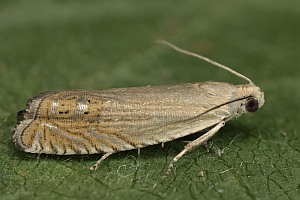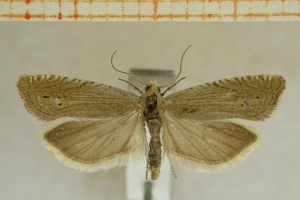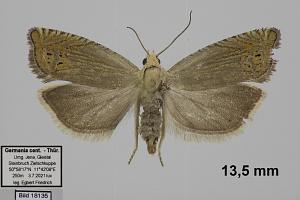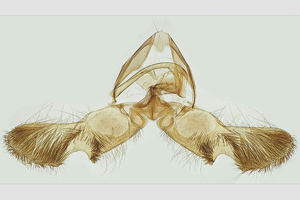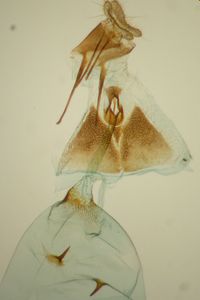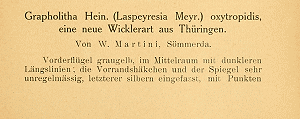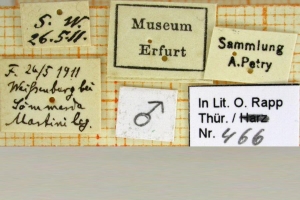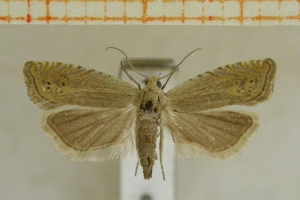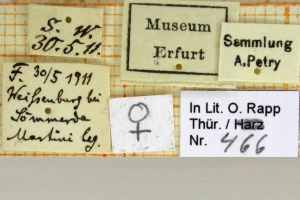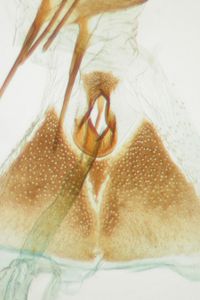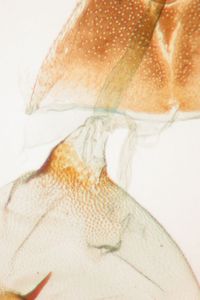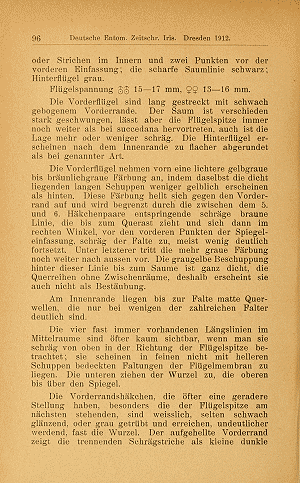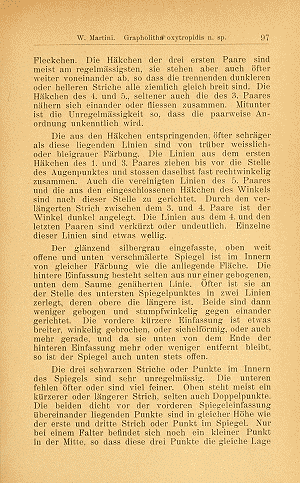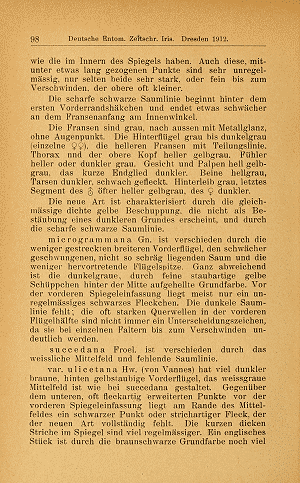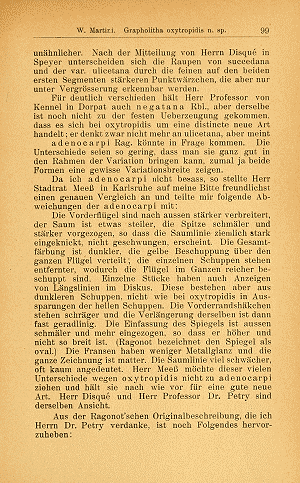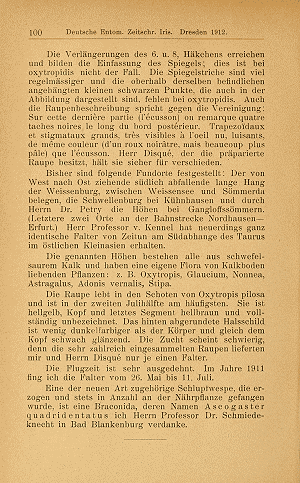

 +16Kontinente:EUAS
+16Kontinente:EUAS2. Diagnose
2.1. Männchen
2.2. Weibchen
2.3. Genitalien
2.3.1. Männchen
2.3.2. Weibchen
2.4. Erstbeschreibung
3. Biologie
3.1. Nahrung der Raupe
- [Fabaceae:] Oxytropis pilosa (Zottiger Spitzkiel, Steppen-Spitzkiel, Gelbe Fahnenwicke)
Schon in der Erstbeschreibung der Art aus Thüringen wurde betont, dass die Raupen sich in Hülsen des Zottigen Spitzkiels entwickeln. Die gleiche Nahrungspflanze wurde dann auch bei der Beschreibung der jetzt synonymisierten Cydia oxytropidana aus den Hautes-Alpes in Frankreich genannt.
Kennel (1921: 659) bezieht sich auf Martini: "Die Raupe ist gelblichweiß, dei Kopf hellbraun bis dunkelbraun, Nackenschild gelblich bis graubräunlich, die Analklappe ohne Auszeichnung; sie lebt im Juli in den Samen von Oxytropis pilosa; der Falter fliegt von Mai bis in den Juni."
Šulcs & Savenkov (2014: 28) geben mit ihrem zweiten Falterfund aus Lettland einen Hinweis auf eine mögliche weitere Nahrungspflanze: "The species was collected by sweep netting from a Astragalus arenarius -growth and by light (09.07.2011, ca. 20 exx.) on dunes close to VTT Užava (IŠ). Probably Astragalus arenarius is a new food plant for C. oxytropidis as the middle-european food plant Oxytropis pilosa does not occur in Latvia. Previously only a single specimen was known from Latvia."
(Autor: Erwin Rennwald)
4. Weitere Informationen
4.1. Etymologie (Namenserklärung)
Synonym C. oxytropidana: Nel & Varenne (2016: 38): « « oxytropidana » pour rappeler sa biologie sur un Oxytropis et ses affinités avec « C. oxytropidis ». »
4.2. Andere Kombinationen
- Grapholitha oxytropidis Martini, 1912 [Originalkombination]
4.3. Synonyme
- Laspeyresia oxytropides Benander, 1946
- Cydia oxytropidana Nel & Varenne, 2016 [synonymisiert durch Huemer & van Nieukerken (2021)]
4.4. Taxonomie
Huemer & van Nieukerken (2021: 316) stellen fest: "Cydia oxytropidana was described from a male holotype and several paratypes of both sexes. Nel & Varenne (2016a) compared the species with C. oxytropidis (Martini, 1912) but based their diagnosis exclusively on genitalia figures published by Razowski (2003). Whereas the discussed differences in male genitalia are subtle, the females of both species seemed to differ strikingly e.g. by the lack of signa in C. oxytropidis vs well developed in C. oxytropidana. However, re-assessment of allegedly diagnostic characters gave a different picture. Male genitalia show intraspecific variation that does not support two species. Similarly female genitalia characters underly some variation as shown by Nel & Varenne (2016a) for C. oxytropidana. Paired signa in female genitalia are a basic structure in Cydia and well developed in all European species. It is therefore suspected that the figure of C. oxytropidis in Razowski (2003), based on a specimen from Ukraine, is erroneous. Other specimens of C. oxytropidis from the Ukraine have normally developed signa (Kavurka 2010) and the same applies to material from Central Europe dissected by PH. Finally we have been able to obtain DNA barcode sequences of the holotype and two paratypes of C. oxytropidana which also fully correspond to C. oxytropidis. We therefore synonymize C. oxytropidana with C. oxytropidis."
4.5. Faunistik
Die Art wurde aus Thüringen beschrieben, wo sie auch noch aktuell vorkommt; Angaben aus anderen Bundesländern Deutschlands fehlen (Gaedike & Heinicke 1999). Laut Fauna Europaea (abgefragt 20. März 2021) kommt die Art in Deutschland, Schweiz, Österreich, Finnland, Litauen, Polen, Tschechien, der Slowakei, Ungarn, Ukraine, Teilen Russlands, Rumänien, im Süden auch in Italien und Spanien vor. Mit dem Synonym Cydia oxytropidana gelang auch der Nachweis für Frankreich (Hautes-Alpes). Razowski (2001: 88) umreißt das Verbreitungsgebiet mit "W und Z Palaearktis: Europa bis S Sibirien, Iran, Tadschikistan und Mongolei." Seine Formulierung "Im gesamten Mitteleuropa verbreitet; lokal" ist trotz der Einschränkung reichlich übertrieben, da schon die notwendige Pflanze in großen Teilen des westlichen/ nordwestlichen Mitteleuropas fehlt.
Kavurka (2010) meldet die Art erstmals für die Ukraine. Šulcs & Savenkov (2014: 28) berichten über den zweiten Einzelfalterfund in Lettland.
4.6. Typenmaterial
Nel & Varenne (2016: 36) schrieben zum Synonym Cyia oxytropidana: « HOLOTYPE mâle : Hautes-Alpes, La Roche-de-Rame, 30 mai 2015, J. Nel leg., Coll. Th. Varenne (Nice), fig. 18a. » — Paratypen: 9 ♂♂ und 7 ♀♀, alle von derselben Fundstelle. Die Autoren der Erstbeschreibung führen außerdem 2 ♂♂, die e.l. aus Oxytropis pilosa gezüchtet wurden, als « Autres exemplaires » auf.
(Autor: Erwin Rennwald)
4.7. Literatur
- Huemer, P. & E. van Nieukerken (2021): Identity of some recently described Lepidoptera from France — re-assessed with DNA barcodes and morphology. — Zootaxa 4941 (3): 301–337. [zum open-access-Artikel und PDF-download auf mapress.com]
- Kavurka, V.V. (2010): New records of tortricid moths (Lepidoptera, Tortricidae) from Ukraine. — Vestnik zoologii, 44 (4): 10-17. [zum PDF-Download auf researchgate.net]
- Kennel, J. (1908-1921): Die Palaearktischen Tortriciden. Eine monographische Darstellung mit 24 Tafeln im Farbendruck, einer Stammtafel und mehreren Abbildungen im Text. — Zoologica 21 (54): 1-546, 729-742, Stammtafel, Taf. I-XXIV. Stuttgart. [Digitalisat auf biodiversitylibrary.org]
- Erstbeschreibung: Martini, W. (1912): Grapholita Hein. (Laspeyresia Meyr.) oxytropidis, eine neue Wicklerart aus Thüringen. — Deutsche Entomologische Zeitschrift „Iris“ 26 (1): 95-100. Dresden.
- Beschreibung als Cydia oxytropidana: Nel, J. & T. Varenne (2016): Entomologie prospectrice : description de la femelle de Nematopogon argentellus G. & P. Leraut, 2014 et découverte de huit espèces de microlépidoptères nouvelles pour la France ou pour la science (Lepidoptera, Adelidae, Tineidae, Bucculatricidae, Gracillariidae, Yponomeutidae, Gelechiidae, Tortricidae). — Revue de l'Association Roussillonnaise d'Entomologie 25 (1): 28-40.
- Razowski, J. (2001): Die Tortriciden (Lepidoptera, Tortricidae) Mitteleuropas. Bestimmung - Verbreitung - Flugstandort - Lebensweise der Raupen. — 319 S.; Bratislava.
- Šulcs, I. & N. Savenkov (2014): New and rare Lepidoptera for the Latvian fauna. Report № 16. — Baptria, 39 (1): 25-29. [PDF (ganzes Heft) auf perhostutkijainseura.fi]















